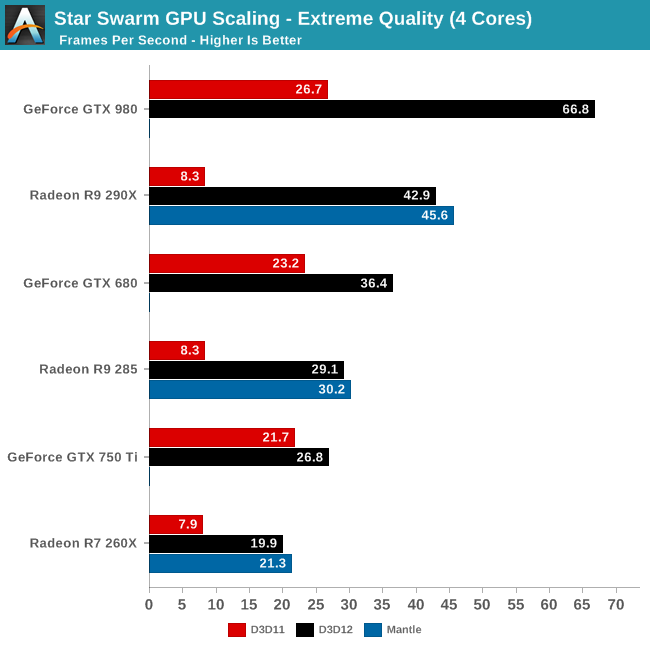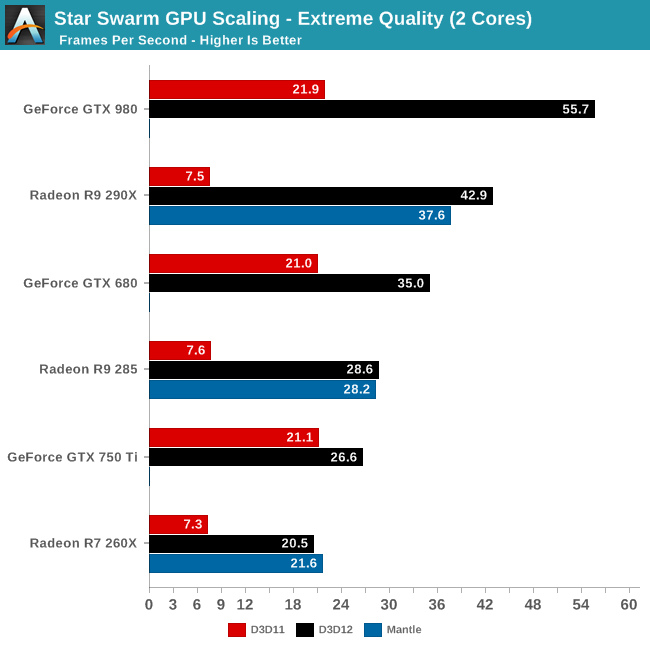The DirectX 12 Performance Preview: AMD, NVIDIA, & Star Swarm
by Ryan Smith on February 6, 2015 2:00 PM EST- Posted in
- GPUs
- AMD
- Microsoft
- NVIDIA
- DirectX 12
GPU Scaling
Switching gears, let’s take a look at performance from a GPU standpoint, including how well Star Swarm performance scales with more powerful GPUs now that we have eliminated the CPU bottleneck. Until now Star Swarm has never been GPU bottlenecked on high-end NVIDIA cards, so this is our first time seeing just how much faster Star Swarm can get until it runs into the limits of the GPU itself.

As it stands, with the CPU bottleneck swapped out for a GPU bottleneck, Star Swarm starts to favor NVIDIA GPUs right now. Even accounting for performance differences, NVIDIA ends up coming out well ahead here, with the GTX 980 beating the R9 290X by over 50%, and the GTX 680 some 25% ahead of the R9 285, both values well ahead of their average lead in real-world games. With virtually every aspect of this test still being under development – OS, drivers, and Star Swarm – we would advise not reading into this too much right now, but it will be interesting to see if this trend holds with the final release of DirectX 12.
Meanwhile it’s interesting to note that largely due to their poor DirectX 11 performance in this benchmark, AMD sees the greatest gains from DirectX 12 on a relative basis and comes close to seeing the greatest gains on an absolute basis as well. The GTX 980’s performance improves by 150% and 40.1fps when switching APIs; the R9 290X improves by 416% and 34.6fps. As for AMD’s Mantle, we’ll get back to that in a bit.

Having already established that even 2 CPU cores is enough to keep Star Swarm fed on anything less than a GTX 980, the results are much the same here for our 2 core configuration. Other than the GTX 980 being CPU limited, the gains from enabling DirectX 12 are consistent with what we saw for the 4 core configuration. Which is to say that even a relatively weak CPU can benefit from DirectX 12, at least when paired with a strong GPU.
However the GTX 750 Ti result in particular also highlights the fact that until a powerful GPU comes into play, the benefits today from DirectX 12 aren’t nearly as great. Though the GTX 750 Ti does improve in performance by 26%, this is far cry from the 150% of the GTX 980, or even the gains for the GTX 680. While AMD is terminally CPU limited here, NVIDIA can get just enough out of DirectX 11 that a 2 core configuration can almost feed the GTX 750 Ti. Consequently in the NVIDIA case, a weak CPU paired with a weak GPU does not currently see the same benefits that we get elsewhere. However as DirectX 12 is meant to be forward looking – to be out before it’s too late – as GPU performance gains continue to outstrip CPU performance gains, the benefits even for low-end configurations will continue to increase.










245 Comments
View All Comments
Jeffro421 - Thursday, February 12, 2015 - link
Something is horribly wrong with your results. I just ran this benchmark, on extreme, with a 270X 4GB and I got 39.61 FPS on DX11. You say a 290X only got 8.3 fps on DX11?http://i.imgur.com/JzX0UAa.png
Ryan Smith - Saturday, February 14, 2015 - link
You ran the Follow scenario. Our tests use the RTS scenario.Follow is a much lighter workload and far from reliable due to the camera swinging around.
0VERL0RD - Friday, February 13, 2015 - link
Been meaning to ask why both cards show vastly different total memory in Directx diag. Don't recall Article indicating how much memory each card had. Assuming they're equal. Is it normal for Nvidia to not report correct memory or is something else going on?Ryan Smith - Saturday, February 14, 2015 - link
The total memory reported is physical + virtual. As far as I can tell AMD is currently allocating 4GB of virtual memory, whereas NVIDIA is allocating 16GB of virtual memory.trisct - Friday, February 13, 2015 - link
MS needs a lot more Windows installs to make the Store take off, but first they need more quality apps and a competitive development stack. The same app on IOS or Android is almost always noticeably smoother with an improved UI (often extra widget behaviors that the Windows tablet versions cannot match). Part of this is maturity of the software, but Microsoft has yet to reach feature parity with the competing development environments, so its also harder for devs to create those smooth apps in the first place.NightAntilli - Friday, February 13, 2015 - link
We know Intel has great single core performance. So the lack of benefits for more than 4 cores is not unsurprising. The most interesting aspect would be to test the CPUs with weak single core performance, like the AMD FX series. Using the FX series rather than (only) the Intel CPUs would be more telling. 4 cores would not be enough to shift the bottleneck to the GPU with the FX CPUs. This would give a much better representation of scaling beyond 4 cores. Right now we don't know if the spreading of the tasks across multiple threads is limited to 4 cores, or if it scales equally well to 6 threads or 8 threads also.This is a great article, but I can't help feeling that we would've gotten more out of it if at least one AMD CPU was included. Either an FX-6xxx or FX-8xxx.
Ryan Smith - Saturday, February 14, 2015 - link
Ask and ye shall receive: http://www.anandtech.com/show/8968/star-swarm-dire...NightAntilli - Tuesday, February 17, 2015 - link
Thanks a lot :) The improvements are great.0ldman79 - Monday, February 16, 2015 - link
One benefit for MS to have (almost) everyone on a single OS is just how many man hours are spent patching the older OS? If they can set up the market to where they can drop support for Vista, 7 and 8 earlier than anticipated they will save themselves a tremendous amount of money.Blackpariah - Tuesday, February 17, 2015 - link
I'm just hoping the already outdated console hardware in PS4/Xbone won't hold things back too much for the pc folks. On a side note... I'm in a very specific scenario where my new gtx 970, with DX11, is getting 30-35 fps @ 1080P in battlefield 4 because the cpu is still an old Phenom 2 x4... while with my older R9 280, on Mantle, the framerate would stay above 50's at all times at almost identical graphic detail & same resolution.